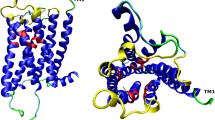Abstract
Studies of imidazole-4,5- and pyrazole-3,4-dicarboxylic acid derivatives revealed a number of new agonists and antagonists of N-methyl-D-aspartic acid (NMDA) receptors. Studies were based on whole-cell patch-clamp methods applied to rat hippocampus pyramidal cells. Increases in the lipophilicity of the environment of the nitrogen atom, keeping the distance between the terminal acid functions constant, led to a weakening of NMDA antagonism and increases in NMDA antagonism. Increases in the lipophilicity around the nitrogen atom could also lead to less of selectivity in the interaction with NMDA receptors and the appearance of non-NMDA antagonist properties.
Similar content being viewed by others
References
I. Ya Aleksandrova, V. S. Khrustaleva, and N. V. Khromov-Borisov, “Diamides of 1-alkyl- (and 1-glycosyl)imidazole-4,5-dicarboxylic acid,”Zh. Org. Khim.,19, 416–420 (1984).
N. B. Vinogradova and N. V. Khromov-Borisov, “Derivatives of imidazole dicarboxylic acids. I. Alkylated amides of imidazole-4,5-dicarboxylic acid,”Zh. Org. Khim.,31, 1466–1470 (1961).
N. B. Vinogradova and N. V. Khromov-Borisov, “The synthesis and mechanism of formation of bis(methylamides) of pyrazoledicarboxylic acids,”Khim. Geterotsik. Soed.,4, 685–694 (1968).
V. I. Petrov, L. B. Piotrovskii, and I. A. Grigor'ev,Excitatory Amino Acids [in Russian], Volgograd (1997).
I. V. Ryzhov, I. P. Lapin, L. B. Piotrovskii, and I. Ya. Aleksandrova, “The selective anticonvulsant action of N-substituted imidazole-4,5-dicarboxylic acids against quinolinic acid,”Byull. Éksp. Biol. Med.,7, 64–67 (1988).
L. S. Éfros, N. V. Khromov-Borisov, L. R. Davidenkov, and M. M. Nedel, “Studies on imidazole derivatives. XIV. Oxidation of benzimidazole and its methyl derivatives,”Zh. Org. Khim.,26, 455–458 (1956).
A. Albert,Selective Toxicity, London, New York, 7th Edition (1985).
C. F. Bigge, C. Humblet, G. Johnson, T. Maloner, D. F. Ortwine, and G. Pinter, “Design, synthesis and molecular modeling of phosphonoalkyl-substituted tetrahydroisoquinolines as competitive NMDA antagonists,” in:Trends in Medicinal Chemistry, S. Sarel, R. Mechoulam, and J. Agranat (Eds.), Blackwell Science Publishers, Oxford (1992), pp. 153–159.
A. Bondi,Physical Properties of Molecular Crystals, Liquids and Glasses, New York (1968).
A. Dorville, I. McCort-Tranchapain, D. Vichard, W. Sather, R. Maroun, P. Ascher, and B. P. Rogues, “Preferred antagonist binding state of the NMDA receptor: synthesis, pharmacology, and computer modelling of (phosphonomethyl)phenylalanine derivatives,”J. Med. Chem.,35, 2551–2562 (1992).
B. Ebert, U. Madsen, K. K. Soby, and P. Krogsgaard-Larsen, “Functional partial agonism at ionotropic excitatory amino acid receptors,”Neurochem. Int.,29, No. 3, 309–316 (1996).
M. Hollmann and S. Heinemann, “Cloned glutamate receptors,”Ann. Rev. Neurosci.,17, 31–108 (1994).
T. N. Johansen, K. Frydenvang, B. Ebert, U. Madsen, and P. Krogsgaard-Larsen, “Excitatory amino acid receptor antagonists: resolution, absolute stereochemistry, and pharmacology of (S)-and (R)-2-amino-2-(5-tert-butyl-3-hydroxy-4-isoxazolyl)acetic acid (ATAA),”Chirality,9, 529–536 (1997).
J. N. Kew, G. Trube, and J. A. Kemp, “State-dependent NMDA receptor antagonism by Ro 8-4304, a novel NR2B selective, non-competitive, voltage-independent antagonist,”Brit. J. Pharmacol.,124, 463–472 (1998).
N. I. Kiskin, A. Ya. Tsyndrenko, M. A. Dumpis, L. B. Piotrovsky, and O. A. Kryshtal, “A novel selective NMDA agonist, N-phthalamoyl-L-glutamic acid (PhGA),”NeuroReport,2, 29–32 (1991).
Excitatory Amino Acid Receptors. Design of Agonists and Antagonists, P. Krogsgaard-Larsen and J. J. Hansen (eds.), Ellis Horwood Ltd., Chichester (1992).
U. Madsen, K. Frydenvang, B. Ebert, T. N. Johansen, L. Brehm, and P. Krogsgaard-Larsen, “N-methyl-D-aspartic acid receptor agonists. Resolution, absolute stereochemistry, and pharmacology of the enantiomers of 2-amino-2(3-hydroxy-5-methyl-4-isoxazolyl)acetic acid (AMAA),”J. Med. Chem.,39, 183–190 (1996).
H. Schubert, S. Hoffmann, G. Lehmann, I. Berthold, H. Meichsner, and H.-E. Polster, “Imidazole-4,5-dicarboxylic acid derivatives, 2,2′-Oligomethylene-bridged bisimidazole-4,5-dicarboxylic acids,”Z. Chem.,15, 481–482 (1975).
J. C. Watkins, “Some chemical highlights in the development of excitatory amino acid pharmacology,”Can. J. Physiol. Pharmacol.,69, 1064–1075 (1991).
Author information
Authors and Affiliations
Additional information
Translated from Rossiiskii Fiziologicheskii Zhurnal imeni I. M. Sechenova, Vol. 85, No. 4, pp. 523–530, April, 1999.
Rights and permissions
About this article
Cite this article
Piotrovskii, L.B., Lishko, P.V., Maksimyuk, A.P. et al. A new class of agonists and antagonists of N-methyl-D-aspartic acid receptors: Derivatives of imidazole-4,5- and pyrazole-3,4-dicarboxylic acids. Neurosci Behav Physiol 30, 553–558 (2000). https://doi.org/10.1007/BF02462614
Received:
Revised:
Issue Date:
DOI: https://doi.org/10.1007/BF02462614




